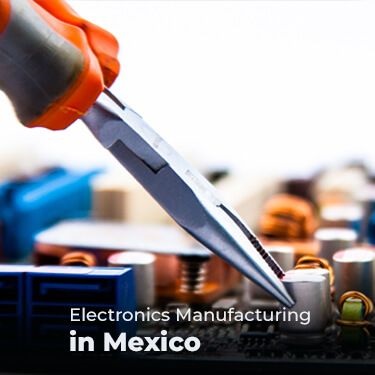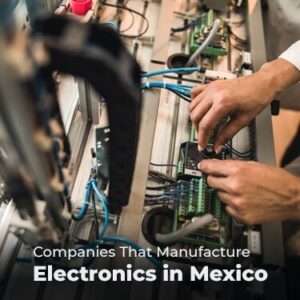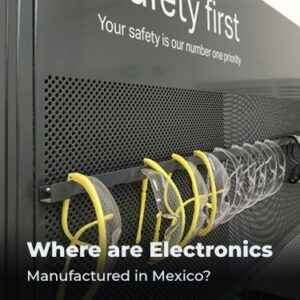
Por
 Copiar URL al Portapapeles
Copiar URL al Portapapeles
Electronics manufacturing in Mexico has boomed since the turn of the twenty-first century, leading to a shift in the country's trading relationships and domestic production. To say that Mexico has been effective in attracting major international electronics companies would be an understatement.
It is a major hub for electronics manufacturing in Mexico these days. Leading multinational corporations have chosen to manufacture electronics in Mexico thanks to some important benefits. These include pro-manufacturing legislation including IMMEX and NAFTA, geographical proximity to the U.S. and Canada, and stability of a low-wage, high-skill workforce.
Electronics manufacturing in Mexico is one of the most exciting economic stories of our time. It's certainly not something many would have predicted in the 1980s. Mexico has very little in the way of home-grown electronics businesses but, as you'll learn, Mexico's electronics industry grew out of a set of beneficial circumstances and a healthy dose of geographic good fortune.
Table of Contents
Electronics manufacturing in Mexico is flourishing. Data suggest that output for the sector grew by 73% between 2002 and 2012, with the value of related exports rising from a healthy $43.3 billion to an impressive $74.9 billion. By 2014, Mexico's electronics industry was worth $80 billion.
Today, Mexico has the sixth largest electronics industry in the world behind China, Japan, USA, South Korea, and Taiwan. Manufacturing represents 19% of total national output at the last count. Mexico is the world's largest exporter of flat-screen TVs - thanks to a decades-long investment by companies like Sony - and it is the world's third-largest exporter of computers.
Why has Mexico had so much success on the manufacturing front? Why is it that a country in Central America has seen such massive growth in its electronics industry output?
Part of the reason has to do with location. Mexico is geographically close to the USA, the largest consumer market for electronics in the world. The US alone consumed more than $36.6 billion in TVs, computers, and video tech from the country in 2016.
Mexico is also just a short hop from Canada - to which it exports more than $8 billion (2016) per year - and Latin America, one of the fastest-growing emerging markets in the world.
Today, Mexico is ranked eighth in the world for electronics exports and is the largest electronics exporter in Latin America.
 Impact of Free Trade Agreements
Impact of Free Trade AgreementsGeographical proximity to major markets, however, is just one part of the story. Another critical driver of the growth of electronics manufacturing in Mexico has to do with free trade agreements, particularly NAFTA.
Free trade agreements allow Mexico to specialize in the types of products in which it has a comparative advantage. Mexico has more skilled labor than the US or Canada relative to its total labor force, making it an ideal location for companies to set up manufacturing plants. The country is similar to China ten years ago in that regard: inexpensive labor is abundant. Companies can use it to keep costs down and deliver more competitively-priced products. If tariffs were still in place, Mexico's specialization in the electronics sector might not have happened.
Mexico is a member of multiple free trade agreements with countries across the world, helping it to price its electronics exports competitively in domestic markets. The vast majority of the deals remove any taxes and tariffs on Mexican goods entirely, allowing the country to price its products at fair market value.
Here are some of the country's flagship free trade agreements:
You can track the effect of these free trade agreements on the pattern of Mexico’s international trade. The country's primary trading partners are precisely the markets with which it has free trade agreements. Mexico's exports to Japan, for instance, are much higher than you'd expect based on geographical proximity alone.
 Technological Advancements
Technological AdvancementsMexico's electronics manufacturing success story isn't entirely home-grown. The country has benefited from its unique trade, labor, and geographic location, but technology transfers played a role too. International companies brought their expertise with them, and in so doing, provided the country with a wealth of knowledge.
Foreign firms created joint ventures with Mexican companies, working together to deliver internationally-competitive products. These companies shared their knowledge base with the incumbent industry, benefitting Mexico enormously and leading to step-changes in production efficiency.
The most important part of the story is how joint partnerships have enabled Mexico to take ownership of foreign technology. The merging of international and domestic companies gave the central American state a competitive advantage it could use to cement its place among the world's top electronics manufacturers.
Technology transfers led to a substantial improvement in the quality of electronics emerging from the country. Products from Mexico can now compete on the international stage and are beginning to garner a reputation for excellence. We've seen a snowball effect: the better the quality of Mexican manufacturing, the higher the foreign direct investment. The more investment from abroad, the better the quality of the final product, and so on. It's a virtuous cycle that has catapulted the electronics output of the country.
Mexico, like many other manufacturing locations around the world, is part of a chain of production. Foreign countries manufacture components for a range of electronics goods and send them to Mexico for assembly into the final product. To say that Mexico produces a specific type of electronics product is to underestimate the complexity of the global supply chain.
With that said, there are specific examples of popular products made in Mexico.
 Companies That Manufacture Electronics in Mexico
Companies That Manufacture Electronics in MexicoThe list of well-known companies that manufacture electronics in Mexico is extensive. The electronics industry was one of the first to migrate across the border from the United States and begin supplying the Californian market.
Some of the biggest names in electronics now have manufacturing facilities in Baja California - the Mexican section of the Californian peninsula which juts out into the Pacific Ocean.
Panasonic, for instance, the Japanese electronics multinational, has facilities in northern Mexico near the border with the US. The company creates all kinds of products and has recently invested substantially in battery production for the ongoing electric vehicle revolution.
Sharp, the Japanese-Taiwanese electronics conglomerate, also has substantial operations located in the region. The original Sharp factory established in Baja California in 1997 made CRT TVs but then switched to LCD TVs in 2001 as technology advanced. The company's Mexican factories now churn out home appliances as well as electronic components used in Sharp TVs assembled elsewhere in the world.
Given the presence of other major Japanese players in Mexico, it should come as no surprise that Sony has a significant presence there. The firm manufactures Playstations for the US market across several Mexican facilities.
 Cost of Manufacturing Electronics in Mexico
Cost of Manufacturing Electronics in MexicoChina proved that if you wanted to develop a robust electronics manufacturing industry, you had to have low domestic labor costs. During the development of Taiwan, Singapore, and South Korea, the electronics sector boomed as multinational companies sought competitive advantage by using the cheap labor that these countries offered.
This is where China’s story differs from Mexico’s. Wages per hour in Chinese manufacturing soared as labor became more scarce from 2005 onwards. Previously, companies had been able to pay manufacturing labor less than $2 per hour, but over the following decade, demand for a dwindling pool of underemployed workers soared and pay soon hit the $5 per hour mark.
The same sequence of events did not happen in Mexico. Labor costs remained low. Even today, you can still buy an hour of manufacturing labor in Mexico for $2 while the price in China and other traditional electronics manufacturing destinations are double that.
Mexico is caught in something of a catch-22 situation. The people of Mexico would like their wages to rise so that they can have a better standard of living, but if they do, then manufacturing may leave for alternative markets. Mexico benefits from low wages and the influx of foreign capital that it brings but may have to undergo yet another shift in its economy if companies leave.
Will wages stay low in the country? The answer is "probably." There are serious headwinds holding wages back.
China is, of course, still very much a middle-income country. It's enormous population, and political clout often betray the low standard of living that the vast majority of people who live in the country endure. The economy is growing fast, but from an incredibly low level - one we find it hard to understand in the West.
Mexico, like China, is a middle-income country, and its wages are substantially below those paid in the US. Electronics manufacturers, therefore, are prepared to take the risk of locating in the country for production purposes instead of establishing in the US outright. The economic advantages are too compelling.
The average manufacturing wage in the US is around $20.69 per hour (January 2017). The rate in Mexico, as we discussed, is approximately 90 percent lower. It's the same story for Canada. Hourly wages in the manufacturing sector there have hovered between $19 and $20 for the last couple of years. The average take-home pay per month for Mexican unskilled manufacturing workers, by contrast, is around $400 to $500.
 Where are Electronics Manufactured in Mexico?
Where are Electronics Manufactured in Mexico?Many countries develop geographically-concentrated economic hubs where they do the majority of their manufacturing. In Germany, the major manufacturing centers are in the Ruhr. In the UK, the majority of production happens in cities north of the Trent. In the US, manufacturing clusters around towns in Ohio, Illinois, and Pennsylvania.
Regional development like this happens for several reasons: closer integration with suppliers, spillover traffic from other similar companies, and supply of appropriately-skilled labor. In Mexico, however, this has not been the pattern. Electronics manufacturing expanded over the entire country. You're just as likely to find an electronics manufacturing facility in the jungle-ridden Yucatan as you are in Baja California along the US border.
Estimates are that there are more than 730 manufacturing facilities currently located in Mexico. These facilities produce billions of dollars of goods for the American market every year, including telecommunication equipment, computer equipment, and audio-visual products.
The geographic location of electronics manufacturing in Mexico is surprisingly diverse. Both international and domestic companies choose to locate all over the country, including in regions with no electronics manufacturing heritage.
 The Distribution Of Electronics Manufacturing In Mexico
The Distribution Of Electronics Manufacturing In MexicoCentral Mexico states heavily involved in the country's electronics manufacturing sector include Queretaro, Aguascalientes, and Guadalajara. Here you'll find some of the world's most celebrated electronics manufacturers, including Texas Instruments, Siemens, Volex, MTi Electronics, IBM, HP, and Hitachi. Motorola has a facility in Guadalajara which opened in the 1980s to make discrete semiconductors. Cancun, on the Yucatan, was home to Vitelcom, a maker of video and DVD products (until it went out of business in 2007).
The Mexican states which border the US, contribute significantly to the country's electronics output. Tijuana, Mexicali, Reynosa, Torreon, Juarez, and Sonora are home to the lion's share of electronics manufacturers. More international companies are located in Tijuana than any other region, with the state playing host to Sharp, Mitsubishi, Sony, Sanyo, Hitachi, Matsushima, Samsung, Pioneer, Delta, Philips, and many more. Mexicali has factories operated by LG, Thomson, and BenQ, the computer monitor manufacturer.
Juarez is home to a variety of East Asian electronics firms too including computer components company Asus, Japanese laptop-maker Toshiba, Kenwood, and Keytronics. Reynosa is home to Nokia, Philips and Sony.
While the electronics industry is distributed over the country, similar sectors tend to cluster together. So, for instance, you're much more likely to find automotive-related firms in the northeastern state of Reynosa. Likewise, Tijuana is home to the lion's share of Mexico's audio and video firms, and Sonora provides a base for several of the world's largest telecommunications manufacturers, including Motorola, Volex, and Alcatel.
 Availability of an Educated Workforce
Availability of an Educated WorkforceMexico, like many other emerging market economies, wants to emulate the West and build its human capital. The reasons for this are apparent: the more highly educated your workforce, the higher their productivity and, hopefully, their standard of living.
The authorities in Mexico have invested heavily in education, which is having a positive effect on the country's electronics industry.
For years, foreign investors preferred China as a target location for their manufacturing facilities. China didn't have the violence and safety concerns that Mexico had, and its labor was still incredibly cheap. Faced with a choice between the two, most companies preferred the former.
With shifting wage rates, however, that began to change. Wages in Mexico in the year 2000 were considerably higher than they were in China, but since then, the situation reversed. It was now China that was more expensive.
It’s not just about wages, though: Chinese and Mexican labor differ in terms of their educational level too. Thanks to government support, Mexican labor has always been reasonably well educated. The country has invested substantially in education and now enjoys high human capital for its level of income. A large percentage of the population has completed advanced degrees, and those workers are fuelling innovation in Mexico's most dynamic sectors, including electronics manufacturing.
Surprisingly, despite the educational investment, wages remain low in Mexico. Mexico suffers from an underemployment problem that means that labor rarely becomes scarce. This strange economic coincidence means that electronics multinationals who move to Mexico can benefit from a low-wage, highly-educated workforce.
The government in Mexico wants to drive better educational attainment in the country. By 2035, Mexico will have among the highest number of students enrolled in tertiary education of any country in the world. The country, however, will fail to reap the economic dividend of more schooling if it cannot translate that investment into productive output. Mexican students need to be in a position to make the companies they join more competitive by bringing their expertise.
 Transportation of Manufactured Electronics
Transportation of Manufactured ElectronicsDespite some structural challenges, Mexico's transport policies have mainly been a success. The country has invested substantially in its highways, ports, and rail networks, making them among some of the best of any emerging market country.
Electronics manufacturers overwhelmingly choose Mexico as a location to produce their goods because of its proximity to the US, Canada, and other significant electronics markets. Mexico is a natural trade point between North and South America, East Asia and Europe. It stands close to some of the world's major shipping routes and, thanks to free trade agreements, can serve as an assembly point for a variety of East Asian electronics manufacturers.
Mexico has the eighth largest export market in the world, exporting more than $165.3 billion every year. Mexico has managed to grab market share from other countries in Central America and the Caribbean, owing partly to the extensive development of its transport network.
Mexico depends heavily on its 70,000 miles of highways. Companies use the road network to transport electronics via truck from ports to factories and then north of the border into the United States. Data from Team Nafta indicates that more than 86 percent of all trade between Mexico and the US happens on roads.
Some of the routes are exceptionally high quality, making trucking easy. Route 57, which runs between Mexico City and Laredo in Texas, is one of the best examples of successful Mexican investment in its road network. The route now handles the vast majority of traffic moving out of Mexico and into the US mainland.
The Mexican rail network, Ferrocarriles Nacionales de México, operates more than 16,500 miles of rail across a variety of routes. The country's rail network was once poorly managed, but since the privatization of more than 80 percent of the system, the country has seen substantial improvements.
For Mexico, rail is key to the growth of the electronics industry. Firms can use rail to transport materials from ports to factories at exceptionally low cost - much lower than by road. The automotive industry, in particular, is investigating whether it can make better use of the country's existing rail infrastructure. And the Mexican government has indicated that it wants to improve rail links with the US in the future, increasing trade between the two countries.
The majority of Mexico's infrastructure is geared toward supplying the US. Historically, that is how the country earned foreign exchange. Today, though, Mexico is beginning to recognize its global strategic advantage in the production of electronics. Audio and video, phones and TVs may not have originated in the country, but Mexico knows that it is the place where companies will assemble them for the foreseeable future.
The country, therefore, is looking to diversify its economy by improving its transportation network and selling to a broader range of countries. Historically, Mexico's port network was poorly developed. The country's ports were dominated by the state, with 16 operated at the federal level, and five at the state level. The only private seaport in the country is in Acapulco.
Mexico knows, however, that if it wants to take advantage of its competitive advantage, it needs to develop its port infrastructure. Improving port infrastructure is likely to encourage electronics manufacturers to use Mexico not just as a base for their US-bound production, but the whole world.
Mexico stands to benefit from better port infrastructure in other ways too. The country currently has more than 31 trade agreements, more than any other country in the world. It's an export-led nation, and one with unique features that make it a new major hub for the export of electronics. Improving its port facilities will lower the cost of transporting goods in and out of the country, and help to increase its current 250 million ton annual capacity.
Working with an electronics manufacturer in Mexico is easier than many people imagine. The country has taken significant strides in recent years to make its domestic environment friendlier to international business.
The main draw of choosing an electronics manufacturer in Mexico is the price. Lower wage rates and, sometimes, material costs, make it a compelling location.
Choosing an electronics manufacturer, however, isn't just about finding the one which offers you the lowest cost. You'll also want to consider a range of other factors.
Loss of control is one of the most significant costs of choosing an offshore manufacturing partner. You get access to lower prices but have to accommodate other issues, such as the language barrier or a lack of expertise at the other end. It's a tradeoff.
In the electronics sector, this lack of control may be more costly than in other areas. Communicating your needs may be more difficult, and you may have to ensure that manufacturers are more precise and provide highly detailed specifications.
The good news is that many multinationals that operate in Mexico have English-speaking people with whom you can discuss your needs. Having a contact like that in a firm makes it inherently easier to arrange shipping logistics and inventory management.
Why work with a manufacturer that operates across multiple facilities? Two reasons:
Many companies in the US who work with Mexican electronics manufacturers try to find those that offer them the best of both worlds: facilities in both the US and Mexico. US manufacturing facilities allow you to communicate complex ideas in your native language, while those in Mexico operate at low cost. You can get rapid turnaround times for prototypes from US-based electronics manufacturers and then ramp up production in Mexico once you're satisfied with the output.
Ideally, you want it to be easy to access any manufacturing facility you use in Mexico. You can use manufacturers in the central and southern regions of the country - no problem. But if you want easy access, then it's worth considering facilities in the north. As discussed above, rail and road serve these locations well, making them highly accessible, should you need to visit.
The advantages of choosing Mexico over East Asia are tremendous for any US-based enterprise. It's much easier to visit facilities when they're just over the border to the south instead of tucked away in a Chinese factory, thousands of miles across the ocean. Mexican electronics manufacturers will often claim to be ISO 9001 certified, but you'll still want to send your quality inspectors ahead of time to ensure that they are following protocol.
Finally, you'll want to investigate lead times - how long it takes a manufacturer to go from inception to delivering the final product. In East Asia, prices may be lower, but lead times longer.
Why are lead times so much shorter in Mexico? Again, it comes down to geographical location. It's just much easier to ship goods by road to the US than get them transported by ocean liner from the Far East.
How long can you expect to wait for the delivery of electronics manufactures from Mexico? Usually, you're looking at a matter of weeks, not months, especially if the companies that you're dealing with have spare capacity.
So, to sum up, if you're planning on working with a Mexican electronics manufacturer, you need to consider more than the cost. You need to ask yourself whether the lead time reduction is worth the extra money, whether the facilities comply with international guidelines, such as ISO 900 and IPC 620. You'll also want to find out how accessible the facility is: can you go and visit, walk around and take notes?
Choosing an offshore electronics manufacturing partner in Mexico also with multiple facilities offers a host of additional benefits. When a manufacturer has facilities that straddle Mexico and the US, it helps to cut lead times and improves communication while still allowing you to take advantage of lower costs.
If your business manufactures electronics in Mexico, transporting your goods from Mexico to US Heavy Haul is critical to the overall supply chain of your products. We specialize in cross-border logistics and apply over 30 years of experience to maximize the efficiency of your supply chain. Whether you’re new to the industry or you’re an experienced veteran, our services are individually designed to meet your unique needs.
In addition to arranging for the transport of your goods, our full-service approach provides additional services that your business might benefit from. We can help you with the benefits of maquiladoras, the tax benefits of maquiladoras, and shipping everything from shoes to tomatoes.
Our other cross border freight services include:
When you’re ready to move forward with cross border shipping to Otay Mesa or anywhere else, contact us to receive a quote for your freight shipment.
 Copiar URL en el Portapapeles
Copiar URL en el Portapapeles
